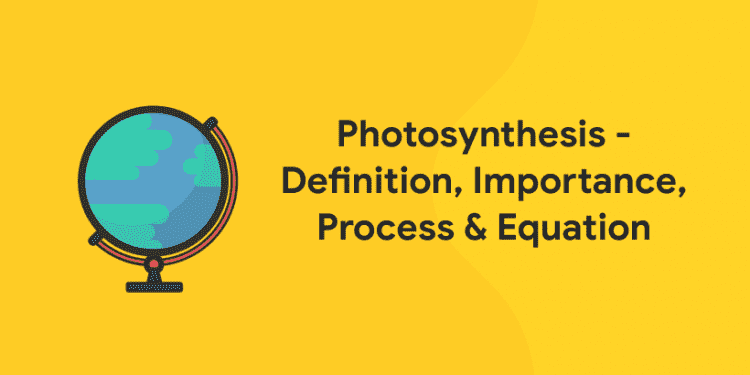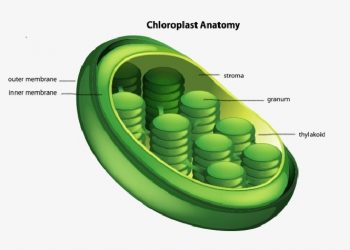Table of Contents
All living beings require food for existence. This is applicable to plants as well as animals. Furthermore, the green plants on earth have a unique ability to produce their own food. They use raw materials like sunlight, water and carbon dioxide to prepare the food by a process called photosynthesis. However, animals including human beings cannot synthesize their own food. Therefore, they depend directly or indirectly on plants for their food.
In this article, you will learn all you need to know about photosynthesis. Firstly, we will define photosynthesis in the simplest possible way. Secondly, we will acquire an awareness on the importance of photosynthesis. Finally, we will describe the process with suitable equations.
What is Photosynthesis?
Photosynthesis is a physio-chemical process by which plants prepare food with the help of carbon dioxide and water, in the presence of sunlight and chlorophyll. In this process, the conversion of solar energy to chemical energy takes place. The food is in the form of carbohydrates. In addition to this, oxygen is the by-product of this process. The following equation depicts the whole process, for instance
Apart from plants, there are a few other species that can undergo photosynthesis. This include Algae, cyanobacteria and certain sulfur bacteria, for instance.
Ace your preparations with Entri!
Importance of Photosynthesis
1: Who was the first woman President of India?
Photosynthesis is important for the existence of life on earth. It is because, plants are the sole autotrophs in the planet. They are the primary producers. Hence, if they do not undergo photosynthesis, all the other organisms which are directly and indirectly dependent on the plants for food, will find it hard to survive. This is true to all the animals including heterotrophs and saprotrophs, for instance. It may even lead to disappearing of many animals from earth. In short, the very existence of life on earth will be in danger.
Apart from this, all living things breathe in oxygen. The humans, animals and other living beings use the oxygen liberated in the process of photosynthesis during the process of respiration. Therefore, photosynthesis is an indispensable factor to keep the life cycle uninterrupted.
- The Carbon Cycle would cease to occur without photosynthesis.
- It is ecologically important to remove the excess carbon dioxide in nature.
- The co-existence of plants, humans and animals is possible only due to photosynthesis.
- The photosynthesizing plants produce many economically useful products. This include, paper, cotton and natural fibres for instance.
To sum up, photosynthesis helps to harness the sun’s energy into useful and utilizable forms of energy on earth.
Free UPSKILLING Courses!
Take your first step toward mastering in-demand skills, acing interviews, and securing top-tier jobs with Entri's free upskilling courses.
Start Learning!The Process of Photosynthesis
By now, we already know that photosynthesis is a physio-chemical process that transforms light energy to chemical energy. Furthermore, it involves various reactions.
The next question subsequently is,
Where does Photosynthesis take place?
Photosynthesis takes place in the green leaves of the plants. Besides leaves, plant parts like green stem and green branch can also take part in photosynthesis.
Photosynthesis occurs in chloroplasts. It is type of plastid exclusive to the plant cell. These plastids are green in color due to the presence of chlorophyll pigment. They are usually found in the guard cells of the leaves.
Structurally, the chloroplasts are double membraned cell organelle. There is an inter membrane space between the two membranes, in addition. Furthermore, the two distinct regions found inside a chloroplast are Grana and stroma. The following table depicts the functions of grana and stroma.
| Grana | Stroma |
| Made up of thylakoids which are stacks of disc shaped structures. | Colorless, aqueous, protein-rich fluid which is similar to cytoplasm. |
| Consists of chlorophyll pigment essential for photosynthesis. | Contains the grana along with DNA, ribosomes, etc. Additionally, it connects the stacks of thylakoids. |
The chloroplasts have important functions to perform, in particular. Given below are some of them.
- They are the site of photosynthesis in eukaryotic cells (including plants and algae).
- In addition to synthesizing food, they are the key organelles for pathogen defense.
- Since plants lack a complete immune system, they serve as immune response cells.
- They produce energy in the form of ATP and NADPH.
- It is the location for light reactions and dark reactions.
Know more about the Plant Cell!
The Stages of Photosynthesis
Let us now learn the different stages involved in photosynthesis. There are basically four stages in the photosynthetic process. They are:
- Absorption of light
- Electron transport
- Generation of ATP
- Carbon fixation
All the stages are well controlled. This leads to synthesis ample amount of carbohydrate for the plant. However, they are classified as light dependent and light independent stages conveniently. Let us learn each stage in detail.
Absorption of light
It is the initial step in the process of photosynthesis. The chlorophyll pigment attached to proteins in the thylakoid membranes performs this process. Furthermore, there are five important types of chlorophylls. These are Chlorophyll a, b, c, d and bactriochlorophyll. The chlorophyll a absorbs light in the blue-violet region whereas chlorophyll b absorbs red-blue light. Moreover, both a and b reflect the green light. Therefore, chlorophyll pigment appears green in color. The main function of the energy absorbed by light is to remove electrons from water. Subsequently, this process liberates oxygen. Furthermore, we shall represent this reaction by an equation as given below:
2 H20 ——> O2 + 4H+ + 4e-
Apart from the chlorophyll pigment, plants also possess carotenoids. To be specific, they are a much larger group of pigments. However, in photosynthesis carotenoid pigments function as reliable molecules to dispose excess energy. It is very essential. Otherwise, if the light energy is not handled properly by the leaf, significant damage may be induced to the plant itself.
Electron transport
This is the second step in photosynthesis which is light driven. It helps to create a proton gradient. Furthermore, the proton gradient is essential for ATP production. Basically, it is a chain of reactions. Here, the electrons are passed from one component to the other. However, this chain reaction continues until they reach the ultimate electron acceptor. Usually NADP+ is the electron acceptor. The electrons move from a higher energy level to a lower energy level. And this process releases energy . This continues until the end of chain where NADPH is obtained.
Hence, we may summarize the overall reaction of Stage 1 and Stage 2 as follows:
2H2O + 2NADP+ ———> 2H+ + 2NADPH + O2
Generation of ATP
In this step of photosynthesis, energy depleted compounds ADP and NADP+ are converted to high energy forms. Furthermore, the high energy forms are ATP (Adenosine Tri Phosphate) and NADPH (Nicotinamide adenide dinucleotide phosphate). Sugars and other carbon compounds are synthesized by this chemical energy.
In short, this production of high energy ATP and NADPH in plants occur in the presence of light. Therefore, the first three stages of photosynthesis is collectively called ‘The Light Phase’. Moreover, all the reactions taking place here are called light phase reactions.
Carbon fixation
This is the final step in the photosynthetic process. Here, carbohydrates is synthesized by the energy from the light phase (ATP and NADPH) . Furthermore, carbon dioxide and water drives these processes. Consequently, these reactions liberates oxygen into the atmosphere. However, the reactions of this stage are indirectly dependent on light energy. Therefore, all the reactions occurring during this phase of photosynthesis constitute the dark reactions. As a result, it is termed as ‘The Dark Phase’. Additionally, it is often called the Calvin Cycle. Meanwhile, animals reverse this process by using oxygen to generate their own energy. Thus, releasing carbon dioxide and water.
The overall balanced formula of photosynthesis is:
6CO2 + 6H20 ——-> C6H12O6 + 6O2
The end products of photosynthesis are glucose (starch and sucrose) and oxygen. Additionally, the Glucose fuels various cellular activities.
Get free mock test for General Science! Download Entri App!
To summarize, photosynthesis occurs in four different stages involving two complete cycles. Nevertheless, all the processes take place in the chloroplast itself. The factors like light intensity, concentration of carbon dioxide, temperature, pollution and water also affects photosynthesis. Apart from transforming carbon dioxide to oxygen, photosynthesis also plays a major role in maintaining the food chain. That is why, it is true to say that photosynthesis is essential for the existence on life on our plant itself!













